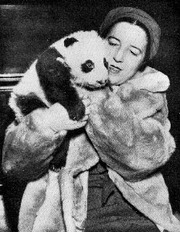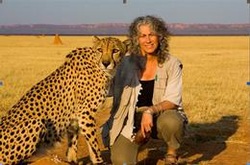 by Yoon Joung Lee Ruth Harkness is often remembered as the first person who brought the alive giant panda to the West. American fashion designer and socialite in New York in the 1930s, Ruth Elizabeth Harkness, was born in 1900 in Titusville, Pennsylvania. Her search of the Giant Panda in China started after her wealthy husband Bill Harkness died by throat cancer in Shanghai in 1936. Her husband was an adventurer who had traveled to China on his own panda-hunting mission. To follow in his footsteps, she decided to complete the mission herself and traveled to Shanghai. In China, she teamed up with a Chinese American explorer named Quentin Young and launched her own panda mission. Young’s main duty was handling logistics and managing the team members, including hunters, cooks, and coolies who carried their equipment. The team consisted of a total of 23 people traveling into deep wilderness and rough mountainous terrain, walking as many as 30 miles a day in temperatures as high as 100 degrees. In November 1936 when they set up a camp near the panda country, they finally encountered and captured a nine-week-old panda cub within a few days. They named the panda, Su Lin, after Young's sister-in-law who bottle-fed baby formula to the Panda on the trip back to Shanghai and the US. Bringing the alive panda from China to the US caused an international sensation over the world and made Ruth Harkness a celebrity of the period. When she returned back to the US, many eager reporters and media fought for delivering her story. The panda was deposited at the Brookfield Zoo in Chicago and brought thousands of visitors. However, the panda died after a year in captivity. Some assume that the changed temperature might have affected it, since panda bears prefer to live in cooler temperatures. Journalist Vicki Constantine Croke in 'The Lady and the Panda' describes that Ruth Harkness was a trailblazing figure whose story makes for an unforgettable, deeply moving adventure. Meanwhile, The Washington Post, introduced her uplifting quote about her interesting viewpoint to look at Westerners in China during her journey. "I felt that I did not need a foreigner; in fact I did not want another foreigner, for by that time I had seen enough of the attitude of most Westerners in China to heartily resent it. Why, because of the difference in the colour of a skin, people sweepingly think of themselves as superior beings, I could not understand, and still don't."  By Yoon Joung Lee Dr. Laurie Marker is one of the world's leading experts on Cheetahs. She was born in 1954 in Detroit, Michigan. In 1990, she got her Bachelor’s of Science in biology from Eastern Oregon State University, and earned a Doctor of Philosophy degree in zoology from the University of Oxford in the United Kingdom in 2003. However, her career with Cheetahs began when she started working at an accredited zoological park called Wildlife Safari, in Winston Oregon, in 1974. She started as a veterinary clinic assistant and quickly became the clinic supervisor. There, she first met the first captive breeding cheetahs. Since then, she has studied on the re-introduction of captive-born cheetahs into the wild and helped identify reasons behind their limited genetic makeup. She is also considered the world’s top expert on cheetahs’ health, reproduction, mortality and genetics. In her early work, she conducted various research on captive breeding of cheetahs at a zoological park in the United States. The results of her groundbreaking studies led her to fieldwork in Namibia.In 1990, she founded the Namibia-based Cheetah Conservation Fund as a not-for-profit organization, which is one of two recipients of the 2010 Tyler Prize for environmental achievement. In this organization, she faced complex problems affecting cheetahs in their native habitat. This organization teams with biologists and other researchers across the world to address the problems, of cheetah predation on livestock and wildlife habitat.The first problem they recognized was a perception by Namibian farmers of cheetahs. The routinely kill cheetahs because cheetahs were seen as threats to their livestock.The second problem they saw was the spread of invasive thorny bushes across the region of Namibia. These bushes block the sight of cheetahs and limit their ability to see animals they are hunting. To solve these two vital issues, she has placed hundreds of guard dogs to protect livestock herds as a non-lethal way to reduce cheetah predation. She also contributed to create an economic enterprise as she cleared thorny bushes from the landscape to process into fuel. Her projects achieved a great result and reputation on Cheetah Conservation Fund among rural Namibians. She was also honored for eco-friendly way to incorporate the knowledge and economic interests of the region. |
Archives
July 2017
Categories
All
|
 RSS Feed
RSS Feed